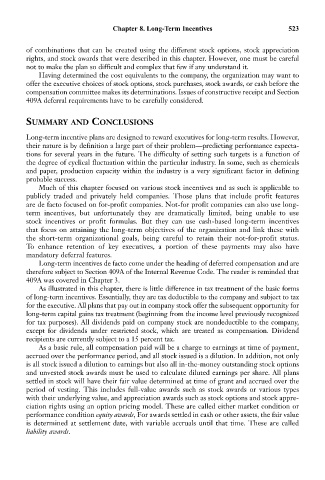Page 537 - Bruce Ellig - The Complete Guide to Executive Compensation (2007)
P. 537
Chapter 8. Long-Term Incentives 523
of combinations that can be created using the different stock options, stock appreciation
rights, and stock awards that were described in this chapter. However, one must be careful
not to make the plan so difficult and complex that few if any understand it.
Having determined the cost equivalents to the company, the organization may want to
offer the executive choices of stock options, stock purchases, stock awards, or cash before the
compensation committee makes its determinations. Issues of constructive receipt and Section
409A deferral requirements have to be carefully considered.
SUMMARY AND CONCLUSIONS
Long-term incentive plans are designed to reward executives for long-term results. However,
their nature is by definition a large part of their problem—predicting performance expecta-
tions for several years in the future. The difficulty of setting such targets is a function of
the degree of cyclical fluctuation within the particular industry. In some, such as chemicals
and paper, production capacity within the industry is a very significant factor in defining
probable success.
Much of this chapter focused on various stock incentives and as such is applicable to
publicly traded and privately held companies. Those plans that include profit features
are de facto focused on for-profit companies. Not-for profit companies can also use long-
term incentives, but unfortunately they are dramatically limited, being unable to use
stock incentives or profit formulas. But they can use cash-based long-term incentives
that focus on attaining the long-term objectives of the organization and link these with
the short-term organizational goals, being careful to retain their not-for-profit status.
To enhance retention of key executives, a portion of these payments may also have
mandatory deferral features.
Long-term incentives de facto come under the heading of deferred compensation and are
therefore subject to Section 409A of the Internal Revenue Code. The reader is reminded that
409A was covered in Chapter 3.
As illustrated in this chapter, there is little difference in tax treatment of the basic forms
of long-term incentives. Essentially, they are tax deductible to the company and subject to tax
for the executive. All plans that pay out in company stock offer the subsequent opportunity for
long-term capital gains tax treatment (beginning from the income level previously recognized
for tax purposes). All dividends paid on company stock are nondeductible to the company,
except for dividends under restricted stock, which are treated as compensation. Dividend
recipients are currently subject to a 15 percent tax.
As a basic rule, all compensation paid will be a charge to earnings at time of payment,
accrued over the performance period, and all stock issued is a dilution. In addition, not only
is all stock issued a dilution to earnings but also all in-the-money outstanding stock options
and unvested stock awards must be used to calculate diluted earnings per share. All plans
settled in stock will have their fair value determined at time of grant and accrued over the
period of vesting. This includes full-value awards such as stock awards or various types
with their underlying value, and appreciation awards such as stock options and stock appre-
ciation rights using an option pricing model. These are called either market condition or
performance condition equity awards, For awards settled in cash or other assets, the fair value
is determined at settlement date, with variable accruals until that time. These are called
liability awards.

